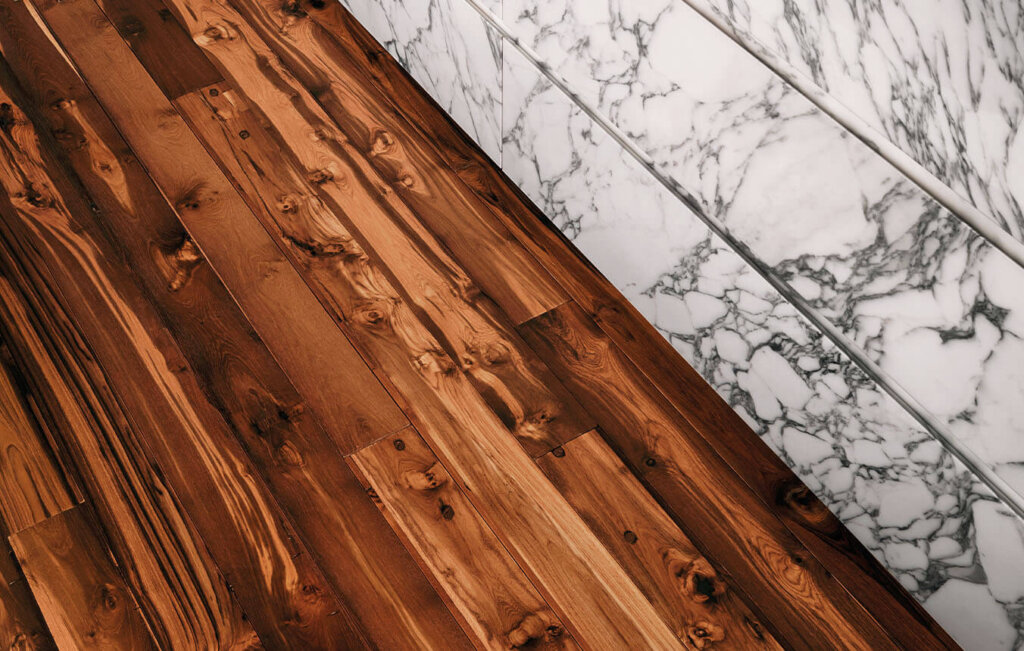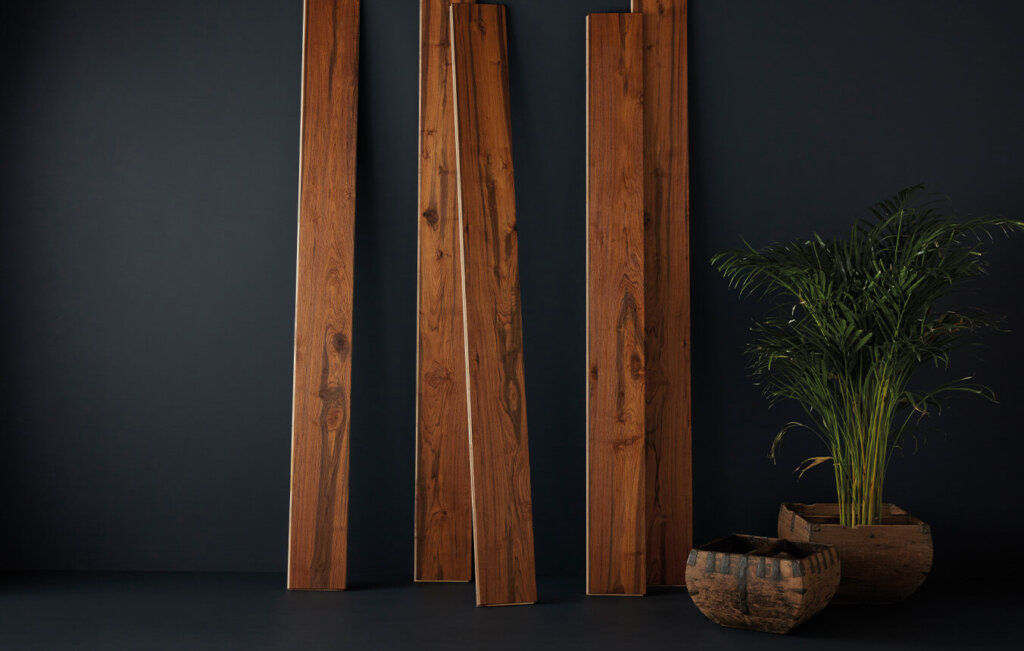There are many teak woods, most of which is native to South and Southeast Asia, with a smattering of teak growing in Africa and the Caribbean too.
However, the key thing about teak nowadays is that, to preserve remaining forests, new teak has become a controlled timber. As a result of it no longer being freely available, it’s become increasingly more difficult to obtain, making it one of the rarest species of wood in the world.
Unlike new teak, reclaimed teak, which we use for our Woodworks floors, is entirely sustainable.
Teak (also known as: Tectona grandis) therefore is increasingly harder to find, especially having survived hundreds of years of history, land, air, weather, and sea before landing at our doorstep.
This tropical hardwood features golden brown tones and is aptly named ‘the king of the hardwoods’ given its extreme durability and water resistance.
What is teak wood?
Real teak wood is amongst the finest materials our planet has to offer, both in terms of durability and beauty.
Known as ‘the King of the Hardwoods,’ teak is celebrated for its incredible durability, which made it a favourite for building colonial homes and structures across East Asia throughout the centuries.
It also naturally resists decay, rot and insects, further establishing itself as the ideal crafting material in these climates and making teak furniture and teak flooring an exceptional choice for both contemporary and classic builds.
Plus, given that teak resists water well, you’ll often find the wood used for a boat building or marine project, which our Woodworks division have years of expertise within.
Visually, the grain pattern of teak is tremendous, with deep straight rings featuring across the surface of the boards. No two boards are the same, and as such our reclaimed teak floors add interest and intrigue to projects.
The heartwood of teak is a warming brown colour which matures and darkens throughout time. Amongst this darkness, silver tones glow during the natural aging process, delivering a regal look to the timber.
When freshly milled, teak produces a fresh, leather-like scent.
Given the scarcity of this resource, all types of teak wood tend to be quite expensive or difficult to acquire as it is only reclaimed and antique teak that is fully sustainable, not new teak.

Where does teak wood come from?
People often ask, where do teak trees grow?
Teak trees grow across much of South and Southeast Asia, with almost half of the world’s naturally occurring teak growing in forests within Myanmar (formerly Burma).
Other nations with teak trees living are: Bangladesh, India, Indonesia, Malaysia, Thailand and Sri Lanka, whilst some teak wood origins lie miles from Asia, within Africa and the Caribbean.
Teak comes from a large deciduous tree which grows to around 50 metres in height and can live up to 100 years in the generous sunshine.
Sadly though, due to over-logging and rabid deforestation, there is an increasingly smaller number of teak trees in the world today. As such, decisive action has been taken.
Teak is one of Indonesia’s most valuable natural resources and is protected by the Indonesian government through forest management programs. Because it can take around 80 years for a newly planted Teak tree to mature, reclaimed and antique teak is key in keeping the species alive.
Where do Ted Todd source their teak wood from?
All Woodworks teak is reclaimed, having been used previously in structures around the world.
Due to the intense over-logging and deforestation in the 1990’s, exportation of new teak was made illegal, hence why only Woodworks only source reclaimed teak, which we carefully restore into beautiful floors with soul and meaning.
This timber is incredibly sustainable, especially when compared to manmade alternatives.
We recycle this wood, putting it back into the manufacturing stage, restarting its lifecycle and increasing the longevity of the wood. Then, throughout the years the reclaimed wood can age gracefully within your project and whenever the cycle should cease, the wood is 100% biodegradable, helping your project reach carbon neutrality.
Our reclaimed teak has arrived from all manner of sites across Southern and Eastern Asia, with much of it being restored from colonial homes across the continent.
As these homes were being renovated and given new life, we took the opportunity to breathe new life into the wood too. The results? Our Dark Colonial Teak, Coburn and two version of Dutch East Indies Teak, one bleached for a modern look, the other maintaining its classic teak look.
We’re always on the look out for sustainable reclaimed teak and assure that each and every board, plank or beam has the relevant paperwork and certifications before the wood arrives at our holding, ready to be restored.

How can you tell good quality teak wood?
The number one thing to look out for when purchasing teak flooring, cladding or even outdoor furniture, is whether the wood has the aforementioned certifications.
Without these relevant accreditation present, the wood may well have been illegally logged or been part of the feral deforestation which led to government action being required.
In terms of appearance, there are a few key indicators of high-quality teak too, which are:
- Colour: The colour should almost glow, with brown hues featuring at the forefront of the wood.
- Grain: The grain should be straight and natural looking.
- Weight: The wood should feel dense and heavy.
- Scent: Teak has a unique leather-like smell that is not shared in other woods.
If all of the above is present, then you can rest assured that the teak is of great quality, which you’ll see in our Dutch East Indies Teak, for example.
Teak wood facts and benefits
- Teak mainly originates in Eastern and South Eastern Asia, with some species of teak growing in Africa and the Caribbean.
- Teak trees grow up to 50 metres high and survive for around 100 years, with a tree being fully matured as early as 25, making it one of the fastest growing hardwoods.
- Close grain patterns are a key feature of teak.
- Golden medium browns that darken over the years are the main colours of teak wood.
- Teak has incredible durability, resisting rot, decay and insects, and water.
- Teak works very well when combined with metals as it doesn’t crack or turn black.
- Older teak trees very often provide the best wood.
- Before it can be cut and used for engineered and solid wood flooring, teak must be kiln dried for around 2 years.
To conclude
Reclaimed teak is amongst the very best wood that can be used for flooring, furniture and beyond, and at Woodworks we are honoured to be able to work so closely with this naturally elegant material.
Experience the stories behind each of our teak wood floors, and order samples to get up close and personal with their natural beauty and wonderful imperfections.